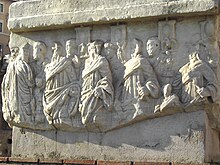relief

A relief [ reˈli̯ɛf ] is an artistic representation that stands out plastically from the background, usually from a surface or a body. As an art form, the relief stands between sculpture and painting .
to form
According to the height of the figures and forms above the base area , there is a choice between bas-relief (also bas-relief ), half-relief and high-relief (also skin relief ). distinguished.
There are hardly any elevation levels in the bas-relief and only a very limited number of curves. It can also only consist of incisions in the underground, see sgraffito . In high relief, the objects shown often protrude from the ground up to half of their actual size. In some cases, elements are designed with undercuts and clearances. The half-relief varies in height and also has rounded edges, but hardly any undercuts.
The recessed relief is used less often. In ancient Egyptian art, for example, the figures and lines were worked into the base as "hollow shapes".
Embedded writings in stone or metal can count as reliefs. The symbolic and divine power of the word is used for expression.
An embossed relief in a round or elliptical frame is a medallion .

A relief as a linear, horizontal style element (for example meander ) is called a frieze in architecture and classical antiquity .
materials
The choice of materials for reliefs is wide: in addition to stone, wood and ivory , metals are used. Art blacksmiths and metal sculptors primarily use bronze , copper , silver , gold , but also cast iron and steel , the latter preferably stainless .
Processing techniques are casting ( bronze casting , iron casting ), driving in flexible materials, engraving , embossing and forging . Also cast stone and easily perishable materials such as chocolate or paper are used in the relief art.
Art history
A heyday the relief in the classic - Greek , Hellenistic and Roman art as decoration on temples and grave steles .
Examples of ancient reliefs in Anatolia and Northern Syria from the 14th to the 12th centuries BC BC come from the Hittite empire and its successors. Pictorial reliefs were carved into the rock, and there are also pure inscriptions in Luwian hieroglyphs . Famous reliefs from antiquity are the giant frieze of the Pergamon Altar , the Parthenon frieze or the Ishtar city gate from Babylon . The reliefs by Lorenzo Ghiberti on the bronze portals of the Baptistery of San Giovanni in Florence are significant in terms of art history and outstanding for their technical execution . They come from the transition from Gothic to Renaissance and are characterized by the new perspective representations. According to the art historian Rolf Toman , "the aesthetics as a criterion for the location of a work of art took precedence over its content".
The largest bas-relief (bas-relief) of modern times is that on Stone Mountain in Georgia (USA), it is the size of a football field and was created in the period 1923–1972.
See also
Web links
Individual evidence
- ↑ Duden online: bas-relief and bas-relief
- ↑ Duden online: high relief and skin relief
- ^ Relief , The large art dictionary by PW Hartmann ", In: BeyArs.com
- ^ Rolf Toman (ed.): The art of the Italian Renaissance. Architecture - sculpture - painting - drawing. Cologne 1994, p. 184

